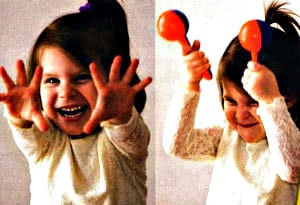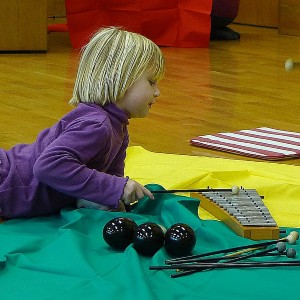Music, Mommy & Me classes
Description of Music, Mommy & Me classes
- Music, Mommy & Me classes for ages 2 to 3 develop children’s’ musical abilities (such as pitch and rhythm) and interest in classical music.
- These classes introduce young children to many elements of music in the form of exciting musical games and with the help of numerous teaching aids. (The program goes far beyond singing and fingerplays.)
- I teach children to play percussion instruments, act out the music of famous classical composers, sing, and dance.
- I have a big collection of percussion instruments: drums, castanets, maracas, tambourines, rhythm sticks, triangles, bells, brass cymbals, xylophones, sand blocks, claves, woodblocks. I bought some of them from different countries, such as Norway, Japan, China, Mexico, Israel.
Adult participation in Mommy & Me classes
Children come to these classes with an adult. It can be anyone: mom, dad, grandparents, nanny. Adult participation is essential. Young children learn not by listening to the instruction, but by imitating people around them. That’s why I require all adults in the class to participate in all our musical games actively.
If I show kids how to clap hands to the music, all adults should do it too. When we have to sing, all adults have to sing, even if not in pitch. When I show kids how to act out music (march like soldiers, fly like birds, walk like elephants, etc.) all adults have to march, fly or walk while I am playing the piano. If some child feels shy, I advise the adult to pick up his/her child and move to music together.
The benefits of Music, Mommy & Me classes
- These classes give young children the first taste of playing the piano.
- Children develop listening skills
- Young kids learn how to behave in a structured environment
- These classes prepare toddlers for the preschool
- Children learn how to socialize with other kids while learning music.
Miss Elena’s advice
for Music, Mommy & Me parents
Singing
While driving home after my class, sing a song that we just learned. Try to sing this and other songs you know as often as you can. Do not worry about your singing voice or if you sing in pitch or not. It is beneficial for your toddler to hear the melody and the words. Your child will be more enthusiastic about singing if he/she will see that you love to sing.
Each week I introduce a new song. The song that we learned last week will not be repeated for at least 10-12 weeks. I have a vast collection of children’ songs. Gradually, you and your child will remember many of them.
Even if you do not have any percussion instruments at home, you can use your hands to make rhythms as you sing. Tap your hands on your knees, toes, table, floor. Your child will enjoy imitating you. At age two, your child will not be able to copy your rhythm precisely. When you sing and clap, it will make catching the beat of the song more natural.
Humming
What about humming a song which your child knows well? Like “Twinkle, twinkle, little star” for example? You can emphasize the fact that you are humming by closing your mouth very tight. You can even make funny faces as you hum – your child will enjoy watching you and will try to do the same.
Whispering
Children pay attention much better when you change the volume of your voice. The kids are natural “noisemakers,” but they will like whispering if you tell them to pretend that they are telling you a secret. You can even whisper the words of the same “Twinkle” instead of singing. It will help your child to hear the rhythm pattern of the words. Just make sure that you keep the correct rhythm of the song as you whisper.
Paying attention to sounds around you and your child
Talk to your child about high sounds of little birds and the low sounds of crows, high sounds of cicadas and the low sound of a bullfrog. Also, there are loud sounds and soft sounds. Try to repeat these different sounds – it will help your child to be more attentive to their surroundings. Teach your child the sounds of animals. Make these sounds loud and soft.
Walking in line
Some younger kids (2 and 3-year-olds) have trouble understanding the concept of walking in line while we are acting out music.
To help your child grasp the idea more quickly, play the game “follow the leader.” Line up members of your family and march, walk or run around a table or a couch trying to stay in line. In my classes, we do it around Treble Clef and Bass Clef. I choose a leader (in Mommy & Me it is two leaders – parent and child) and ask the rest of the class to follow the leader around the room, making a big circle around Grand Staff.
Sometimes, younger kids do not want to move to the rhythm of the music. I solve this problem this way: I tell the adult to pick up their child and march or walk or run with a child in their arms. It has several advantages: child participates in the game, can have a much better view of what everyone is doing, feels the rhythm through the parent’s body, and just feels comfortable and protected.
There is no right or wrong time for a child to become independent and act out music independently of the adult. Usually, progress is as follows:
- a parent carries the child around the room while I play the music by one of our composers;
- a child holds parent’s hand while moving to the music;
- a child walks next to parent without holding hands
- a child acts out music, trying to be as far away from the parent as possible.
Words from our happy
parents and students
“Dear Miss Elena, I remember the day that Evan and I started your “Music, Mommy and Me” classes. It seems like yesterday. Not only were you organized, you always seemed to manage to keep those two-year-olds interested and enthusiastic about what they were learning. Now that takes talent!!”
– Tina Naar




